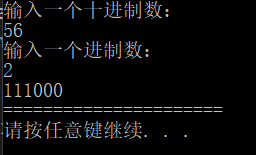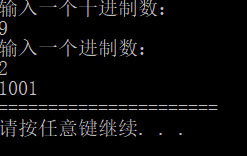基于SqStack 进制计算
#include<malloc.h> #include<stdio.h> #include<stdlib.h> typedef int Status; typedef int SElemType; #define STACK_INIT_SIZE 100 #define STACKINCREMENT 20 #define OVERFLOW -2 #define OK 1 #define ERROR 0 typedef struct SqStack { SElemType *base; SElemType *top; int stacksize; } SqStack; // 顺序栈 Status InitStack(SqStack &S) { // 构造一个空栈S if (!(S.base = (SElemType *)malloc(STACK_INIT_SIZE * sizeof(SElemType)))) exit(OVERFLOW); // 存储分配失败 S.top = S.base; S.stacksize = STACK_INIT_SIZE; return OK; } int GetTop(SqStack S) { // 若栈不空,则用e返回S的栈顶元素 if (S.top>S.base) return *(S.top - 1); } Status Push(SqStack &S, SElemType e) { // 插入元素e为新的栈顶元素 if (S.top - S.base >= S.stacksize) // 栈满,追加存储空间 { S.base = (SElemType *)realloc(S.base, (S.stacksize + STACKINCREMENT) * sizeof(SElemType)); if (!S.base) exit(OVERFLOW); // 存储分配失败 S.top = S.base + S.stacksize; S.stacksize += STACKINCREMENT; } *S.top = e; S.top++; return OK; } Status Pop(SqStack &S, SElemType &e) { // 若栈不空,则删除S的栈顶元素,用e返回其值,并返回OK;否则返回ERROR if (S.top == S.base) return ERROR; //e=*--S.top;//e=*S.top; S.top--; e = *S.top; return e; } Status StackTraverse(SqStack S, Status(*visit)(SElemType)) { // 从栈底到栈顶依次对栈中每个元素调用函数visit()。 // 一旦visit()失败,则操作失败 while (S.top>S.base) visit(*S.base++); printf(" "); return OK; } int main() { SqStack S; int x, y, e,num1; InitStack(S); printf("输入一个十进制数: "); scanf("%d", &x); printf("输入一个进制数: "); scanf("%d", &num1); while (x) { Push(S, x % num1); x = x / num1; } while (S.base != S.top) { y = Pop(S, e); printf("%d", y); } printf(" ====================== "); system("pause"); return 0; }

